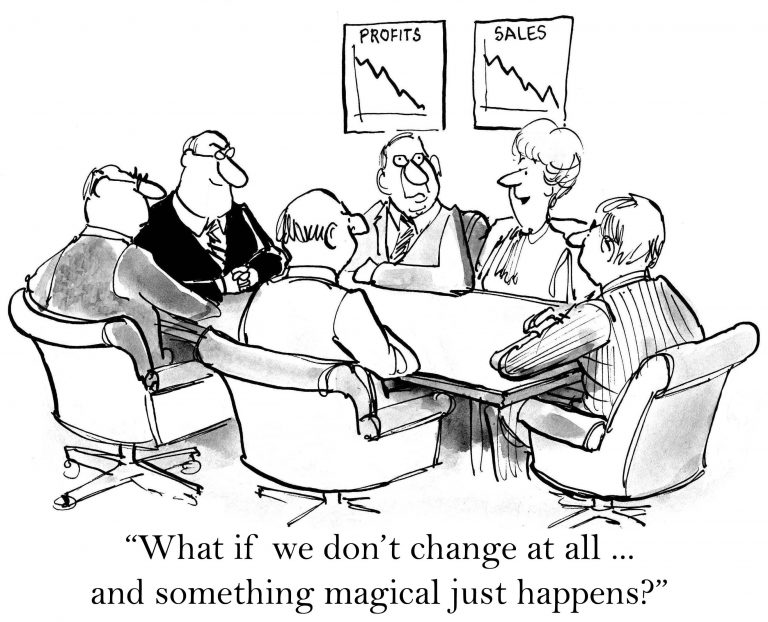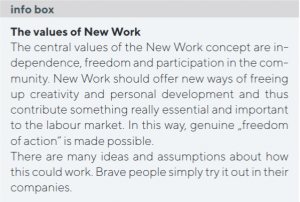New Work, the future of work and the new culture of the people
The world of work has been experiencing fundamental and structural change for some years now. New Work is the epitome of this transformation. But the triggers for this development are manifold. Globalization and demographic change, digitization and connectivity are among the causes for the change in the world of work. The question of how we deal with the New Work megatrend is becoming increasingly urgent.
A glance at the beginning of New Work
New Work is a collective term used to describe various, mostly alternative working models and forms. At the same time, however, the term also marks developments such as the transition to a knowledge society. The common denominator is the New Work concept of Frithjof Bergmann who developed the theoretical concept of the new work in the mid-seventies.
– 1/3 gainful employment
– 1/3 high-tech self-providing and smart consumption
– 1/3 work you really, really want (vocation)
New Work is not really new, but in our rapidly changing society (VUCA, Laloux(1), globalization, digitization, fig. 1) it has gained more dimensions and significance. Terms like Work 4.0 or similar keywords are used to summarize everything we imagine under the “Future of Work” as New Work.
The end of the “old working world”
The various contexts in which the New Work term is currently used let the concept appear rather blurred. Today New Work serves as a buzzword for often precise, but also very different organizational and working models. For example, the term is used in connection with flexible forms of work such as job sharing or agile working methods like Scrum. It describes manifold approaches such as gender empathy or job rotation concepts. However, the New Work label also refers to participatory organizational models, such as holacracy. Digitized forms of collaboration, for example via wikis or social media applications, are also referred to as New Work. Despite this broad spectrum of management and HR concepts, most approaches have one thing in common: they represent a development away from rigid working models towards the flexible value-added processes of the working world 4.0.
Working world 4.0: new environment, new work
Undoubtedly there are many reasons for this development. It is obvious, however, that digital technology has played and continues to play a major role in the emergence and spread of alternative forms of work. Digitization has also contributed to the transformation of economic structures: the Internet has created a globally networked market in which innovations in particular have a major impact.

Figure 1: Planning for success in the new VUCA business world
Many companies have now responded to the challenge of having to deal with the possibility of so-called disruptive technologies: to increase their innovative strength they are introducing flexible working models and methods or use methods of agile project work – originate from software development – which often have similar goals, too.
Changing values – from the industrial society to a knowledge society
As a megatrend the digital transformation also plays a role in the transition from an industrial society to a knowledge society. One feature of today’s society is that knowledge has become a central resource. Although other goods such as capital and raw materials are of course still very important, knowledge is increasingly becoming a determining factor for success – for individuals as well as for companies. The economy has been developing in the direction of knowledge economy. Many activities today not only require knowledge of specialists, but also the ability to exchange ideas and learn continuously. On one hand, the half-life of specialistic knowledge is comparatively short today. On the other hand, many tasks are so complex that the experience of individuals is no longer sufficient to cope with them. A vivid example is the video game industry: in the 1990s it was still possible to program a commercially successful computer game on one’s own. Today, that’s unlikely: today’s video games are so complex that hundreds of people with very different skills are working on them. They all have to exchange ideas with each other constantly – often using new work methods like Scrum.
Dying Jobs and Technology Progress
Perhaps in the not too distant future there will also be a very fundamental question: Suppose, in the progression of automation, machines and intelligent computer programs take over a large part of the tasks to be performed – how do we work then?
The German digital expert Thomas R. Köhler predicts: “The digital transformation will lead to massive changes in the world of work. Some jobs are already at risk until 2020.” According to Köhler, from 2019 the following jobs will disappear faster than previously assumed: Personal managers, warehouse workers, employees in fast food chains, lawyers, construction workers and seafarers are particularly affected. The jobs would be successively filled with computers or artificial intelligence, which would not only be much cheaper “workers”, but also more efficient.
Many are still awaiting the digital job showdown eagerly, although we are already in the middle of it. For almost 20 years, robots have been used in production at the truck assembly plant of Mercedes Benz Trucks in Wörth: driverless transport vehicles in deserted halls; computer-controlled robots weld and paint and have increasingly taken over the jobs of the workers in recent years. A welding robot replaces three to four employees and does an excellent job: precise, continuous and almost error-free.
This does not only apply to the automotive industry. Bitkom President Achim Berg points out that 90 percent of the jobs in German communications technology have already been lost in the last 15 years. The same applies to other professions. The daily newspaper is also a phase-out model, online banking and self-service terminals have become a normal part of everyday life. Comparable erosion at the edges also occurs among lawyers. Simple facts have long since been offered automatically, and legal portals are already often replacing the way to a lawyer. All these developments have long since become reality and have already left their mark on many professions.
“But the real change is still to come,” says Köhler. We are currently experiencing a new wave of automation. The question of what prospects are waiting us on the labour markets in the years to come is more topical than ever – how will they develop?(2)
More and more global – more and more mobile – more and more digital
New technologies – industry 4.0, autonomous vehicles and developments in the field of artificial intelligence – and flexible kinds of work are being performed when and where the market demands it, globally and often around the clock. More and more people in the “old working world” are being asked what they want to do in the future.
WE COME TO NEW WORK BY ANSWERING THE QUESTION: WHAT DO YOU REALLY, REALLY WANT TO DO?
FRITHJOF BERGMANN
Bergmann states a simple and provocative thesis: New Work does not simply emerge when companies equip their employees with new technologies. It takes more than that. “New Work is the result of a long, accompanying process,” continues Bergmann, “which begins with the question of what we really want to do. People should bring their own personality into the work. For many, however, this challenge is first and foremost an excessive demand.” That’s why Bergmann founded the Center for New Work at the end of the 1970s – basically the first consulting firm for New Work. Advice and support are the keys to entering the New Work age.
While many other scientists warn against the consequences of automation and digitization, Frithjof Bergmann welcomes the new technologies. But he also believes that automation and digitization have bad consequences which he finds very regrettable and painful. “Murderous poverty – for me the worst in the world – must of course be combated, and people must defend themselves against it”. In his opinion, this poverty will even intensify and deepen.
In Bergmann’s imagination, however, automation must not be generalized and seen as a danger, but above all that it serves people and frees them from the work they experience as a beginning illness.(3)
So how do we get from old work to New Work (Fig 2)?
How the working world of the future will look like is, of course, uncertain. How can we make the productive transition from the old working world to New Work? Innovative solutions are needed today in ever shorter intervals in order to survive in dynamic markets. The answer to this challenge cannot be a homogeneous working day where all employees are physically present in a department from 9 to 5 o’clock.
In addition to automation and division of labour, strict hierarchies are typical for the old working world. This characteristic of the old working world has prevailed in companies for more than 200 years since the beginning of industrialization. It is pleasing to note that many approaches and instruments for the preparation of New Work are tried out and used in a variety of ways, especially in the area of personnel development. This development is certainly also stimulated by the worldwide shortage of skilled workers. The sensible and ethic use of new technologies is another important starting point and connecting piece.
FUTURE IS THE TIME WHEN YOU RE- GRET NOT HAVING DONE WHAT YOU CAN DO TODAY.
FROM THE USA
To live New Work in the 21st century means for the entrepreneurial everyday life:
– Self-determination and not only wage labour: Reduction of strict hierarchies and creation of temporal and spatial free spaces. People of different professions and back- grounds must be able to meet and exchange ideas so that new ideas and solutions can emerge.
– Cross functional or mixed teams: Since New Work is based on a completely new organization of work, tasks are no longer primarily carried out in departments, but divided into projects. In order to achieve the best possible result, those with the best skills are organized into teams for each project. Teams and whole organizations can be understood as heterogeneous and dynamic net- works. Since the beginning of the 2000s there has been a lot of scientific discussion about this.(4)

– Networked infrastructure: New work needs new infrastructure at different levels. This applies not only to the architecture of buildings, but also to the technical infrastructure and organization. Without connectivity there is no network and New Work remains just a utopia.
– Employee retention: The insight that satisfied employees who identify with their work are more motivated, productive and creative also changes the working structures. New Work’s goal is to retain employees and balance work, social environment and personal interests. This creates a performance-enhancing yet familiar atmosphere.
– Cooperation and co-creation between humankind and technology: Our age is characterized by increasing complexity, rapid technological development, doubling of world knowledge within only 72 weeks, the processing, storage and evaluation of data volumes ranging from Zettabyte to Brontobyte as well as the upcoming revolution of AR, VR, and AI. The existing fears of job loss (machine / software replaces man) and gloomy future scenarios must be considered around a new mindset of cooperation models of man and technology. If techno- logical development is regarded as co-creation, the following advantages result: Cooperation between humans and software increases productivity and effectiveness, processes can be designed more efficiently (standardizable = digitizable), real-time visualization, AR and AI create highly effective learning and development opportunities, new target groups can be opened up even more easily worldwide, new needs arise through the processing of complexity and permanent strain. In many areas, people remain (still) superior in the foreseeable future, e.g. in creative, social and reflexive abilities.

– Corporate responsibility: If the thoughts are consistently pursued, the education system must also be taken into consideration. In today’s education system many central skills that will be essential in the age of New Work have not yet been taught. Companies can exert greater influence on this through targeted cooperation with educational institutions – from kindergartens to universities – and politicians.
To ensure all this, we need courageous experiments, new ideas and a lot of innovative power. Or in short: New Work.
Sources
– 1. Frédéric Laloux, economic philosopher and bestsell- ing author of “Reinventing Organizations”.
– 2. https://www.springerprofessional.de/transformation/ automatisierung/-ganze-berufsfelder-werden-frue- her-oder-spaeter-obsolet-/16098350
– 3. https://www.newwork.global
– 4. http://www.scientificamerican.com/article/how-di- versity-makes-us-smarter/
Scientifican American (Oct., 2014 „How Diversity Makes Us Smarter. Being around people who are different from us makes us more crative, more diligent and harder-working.”)

Maria Bauer
Head of Coaching and Conseling
at Cloudical Deutschland GmbH
maria.bauer@cloudical.io
cloudical.io / cloudexcellence.io
